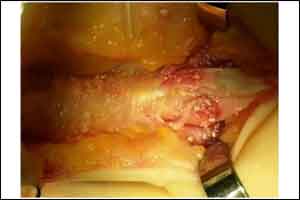- Home
- Editorial
- News
- Practice Guidelines
- Anesthesiology Guidelines
- Cancer Guidelines
- Cardiac Sciences Guidelines
- Critical Care Guidelines
- Dentistry Guidelines
- Dermatology Guidelines
- Diabetes and Endo Guidelines
- Diagnostics Guidelines
- ENT Guidelines
- Featured Practice Guidelines
- Gastroenterology Guidelines
- Geriatrics Guidelines
- Medicine Guidelines
- Nephrology Guidelines
- Neurosciences Guidelines
- Obs and Gynae Guidelines
- Ophthalmology Guidelines
- Orthopaedics Guidelines
- Paediatrics Guidelines
- Psychiatry Guidelines
- Pulmonology Guidelines
- Radiology Guidelines
- Surgery Guidelines
- Urology Guidelines
Flexion deformity of the finger caused by tophaceous gout of the flexor tendon

The case of Flexion deformity of the finger caused by tophaceous gout of the flexor tendon has been published in BMJ Case Reports.
A 53-year-old, right-handed man was referred to the orthopedic clinic with a 1-year history of progressive ‘trigger-like’ symptoms and eventual locking of the right ring and middle fingers. There was no history of trauma or joint problems. Medical history included stable chronic kidney disease and well-controlled hypertension. On examination of the right hand, there was limited passive mobility with complete flexion of the ring and middle fingers by 100° at the proximal interphalangeal joint, and additionally the ring finger by 45° at the distal interphalangeal joint. The left hand was unaffected. Furthermore, in the context of a raised serum uric acid concentration of 767 μmol/L 3 years previously, two palpable, non-tender nodules were found on the left olecranon.
Surgical exploration of the right ring finger found multiple small, white speckled deposits infiltrating the flexor tendon from the first annular pulley (A1) to just beyond the A3 pulley (figure 1). The same deposits were found in the middle finger. In both fingers, the A1 pulley was released followed by washout and debridement, while leaving the tendon sheaths intact. A biopsy was taken which supported the clinical diagnosis of tophaceous gout. Postoperatively, function improved and rheumatological follow-up was arranged.
Gout only affects the hand in a minority of cases (16.9%), and often only in the context of advanced disease. Moreover, specific involvement of the flexor tendons of the hand is uncommon. Tophi as the initial manifestation of gout is also unusual as tophi development is related to disease duration.
References
- Mallinson PI,
- Reagan AC,
- Coupal T, et al
. The distribution of urate deposition within the extremities in gout: a review of 148 dual-energy CT cases. Skeletal Radiol 2014;43:277–81.doi:10.1007/s00256-013-1771-8- Meyer zu Reckendorf G,
- Lupascu D
. Flexor tendons involvement in gout. A case report and review of literature. Chir Main 2010;29:199–202.doi:10.1016/j.main.2010.04.004- Wernick R,
- Winkler C,
- Campbell S
. Tophi as the initial manifestation of gout. Report of six cases and review of the literature. Arch Intern Med 1992;152:873–6.

Disclaimer: This site is primarily intended for healthcare professionals. Any content/information on this website does not replace the advice of medical and/or health professionals and should not be construed as medical/diagnostic advice/endorsement or prescription. Use of this site is subject to our terms of use, privacy policy, advertisement policy. © 2020 Minerva Medical Treatment Pvt Ltd